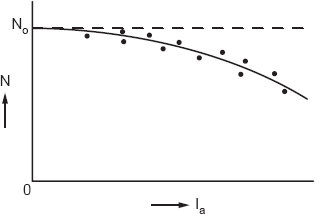
EXPERIMENT 4
4.1Object: Load Test on a D.C. Shunt Motor
We have pointed out that a load test has other names, such as a brake test, speed-torque curve test, or shaft characteristic test. Our object is to find the variation of speed when the torque is changed.
4.2Experimental Setup
A shunt motor, voltmeter, ammeter, tachometer, and torque measuring device are needed.

Figure 4.1
Figure 4.1 represents the D.C. shunt motor with the voltmeter and ammeter connected to the power supply. Power supply to the motor may be received from a separate powerhouse in the laboratory.
The range of the instruments will depend on the capacity of the motor. Read the motor nameplate and note the specifications. The study of the nameplate will decide the range of the instruments.
Start the motor by making a switch “on.” Make the switch on for the motor. Use the three-point starter for starting.
Move the starter handle slowly and steadily; otherwise transients will enter into the machine.
Read the speed, torque, and current. The voltage being constant, we require only one reading. Note this reading in the experimental results.
EXPERIMENTAL RESULTS

Plot the speed-torque curve. Consider the origin at O, O and plot the graph.

Figure 4.2
Plot the graph between torque and current, considering the origin at O, O. The graph is shown in Figure 4.3.
The torque is directly proportional to the armature current. The speed falls with the armature current as shown in the following mathematical expression:


Figure 4.3
A graph plotting speed and torque is shown in Figure 4.1. We show a speed-current curve in Figure 4.4.

Figure 4.4
4.3Discussion
The experimental results are tabulated. The speed falls when we increase the torque. This is due to the armature drop iara. The speed-torque and torque-current curves are shown in Figures 4.2 and 4.3 along with the shaft characteristic.
4.4Input and Output Relations
The input can be found simply as the VI watts
| Input = VI watts | (4.2) |
The output will be t

The efficiency will be:

The efficiency of the motor varies with torque or current, as shown in Figure 4.5.

Figure 4.5
The load is referred to as the torque, T or the current Ia. Some engineers call the current the load in the case of the generator. The current may also be called the load in the case of the motor.
4.5Questions and Answers on the Experiment
Q1. What is the importance of the no-load current of the motor?
Ans. No-load losses such as mechanical losses (friction and windage losses) and copper loss in the field may be determined.
Q2. What will be the efficiency of the motor at a no-load current?
Ans. Zero.
Q3. Which speed will be higher, either no-load speed or full-load speed?
Ans. The no-load speed will be slightly higher than the full-load speed.
Q4. How will you control the speed of a D.C. shunt motor?
Ans. By changing the terminal voltage and changing the field current.
Q5. Which type of starter is used to start the shunt motor?
Ans. Three-point starter.
Q6. Why do we use a starter?
Ans. To build the back EMF slowly. The back EMF takes time to build up as the field current rises. If we apply full voltage to the motor with the back EMF, a high current flow will burn the motor insulation.
Q7. Where would we use shunt motors?
Ans. Shunt motors are used in fans of railway trains, paper mills, textile mills, and flour mills. All appliances which require constant speed are coupled to the shunt motor. The centrifugal pump is connected with a shunt motor.